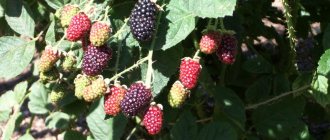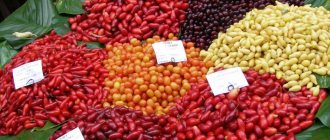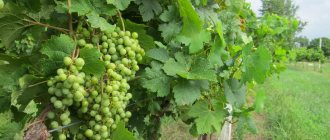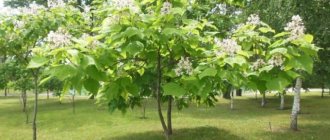Author: Natalya Category: Fruit and berry plants Published: January 29, 2019Republished: February 26, 2019Last edits: November 2, 2020
- Spring care
- Pruning in spring
- Raspberries turn yellow
plant (lat. Rubus idaeus) is a subshrub of the Rubus genus of the Rosaceae family. The genus is represented by approximately six hundred species, many of which became known in the Ancient world: the wild raspberry was first mentioned in manuscripts of the third century BC. Cultural cultivation of raspberries began in Western Europe in the sixteenth century AD. In nature, raspberries most often grow in forests and along river banks, but for many centuries they have been one of the most popular and beloved garden berry crops. Today, perhaps, there is not a single garden in which raspberries do not grow - a tasty and aromatic berry, which is a storehouse of acids, minerals and vitamins necessary for humans. With all its other undeniable advantages, raspberries are unpretentious in the garden; they can grow and bear fruit even in desolation, but proper care of them will help you increase your raspberry yield and protect the bush from diseases and pests.
Planting and caring for raspberries
- Planting: in spring or September-October.
- Lighting: bright sunlight.
- Soil: light fertile soil, optimal pH -5.7-6.5 pH. Neither lowlands, nor steep slopes, nor elevated areas are suitable for growing shrubs.
- Watering: in dry summers - abundantly, so that the soil gets wet to a depth of 30-40 cm. The plant needs water most in May, during the period of growth and ripening of berries and in the fall. The best method of watering is drip. During the season with normal rainfall, raspberries are not watered.
- Garter: In spring, raspberries are tied to a trellis.
- Pruning raspberries: for sanitary purposes - in early spring, before the sap begins to flow.
- Fertilizing: in spring – with nitrogen fertilizers, in autumn – with potassium-phosphorus fertilizers. Before cold weather, the soil is dug up with compost and ash.
- Reproduction: by cuttings, suckers, some species - by rooting the apex.
- Pests: shoot and stem gall midges, spider mites, aphids, raspberry stem flies, raspberry beetles, gall beetles, weevils.
- Diseases: rust, chlorosis, root canker, purple spot, athracnose, viral mosaic, witch's broom, gray rot, white spot, root rot, canker spot.
Read more about growing raspberries below.
Step-by-step instruction
If a gardener decides to plant raspberries in the spring, all stages of planting must be carried out correctly. Only in this case will the bush take root and produce a large harvest.
Selection and preparation of seedlings
The first stage is the most important, since the future growth of the berry will depend on the source material. The best option for planting is a bushy seedling with well-developed roots. It is this kind of seedling that will be able to establish itself very well in the ground the first time.
It is important to pay attention to the root. There should be no dry parts on it that break very easily. The buds on the seedling must be fresh, without dry parts, then the raspberries can quickly take root. Sometimes a plant with dry buds takes root, but this is an exception to the rule and does not need to be followed.
Ideal time to plant
It is best to plant raspberries in natural soil in the first spring months. The ideal time is late March or early April. At this time, frosts are rare and the soil is well saturated with organic matter and moisture. Raspberries planted during this period will grow well and quickly form a root system.
Landing place
The place on the site where raspberries will grow must have certain criteria:
- Plant the raspberries so that they receive as much light as possible.
- The future shrub should be located in a place well protected from the wind.
- Raspberries should always have access to fresh moisture, so do not plant raspberries in areas full of groundwater. Stagnant water should not fall on the roots.
- Do not plant raspberries near currants. It has well-developed roots and will take some of the nutrients from the raspberries.
- Plant the berries in the direction from north to south, then the bush will evenly receive all the nutrients.
If the location does not have all of the above criteria, then the raspberries will grow, but the berries may be less aromatic and not very juicy.
Distance between seedlings
It is very important to control the distance between the bushes - at least 50 cm. But do not plant the bushes very far from each other, this will be inconvenient for further use of the bush.
Raspberries planted at a distance of 50 cm develop evenly. The bushes will not compete with each other. This distance is also convenient for gardeners; they can walk freely between the bushes and loosen the soil or harvest.
Soil preparation
For raspberries, as for other fruit and berry bushes, it is very important in what soil the plant will grow. Light soils are best. As a rule, they are very rich in minerals. If there is no such land on the site, the soil will need to be fed with various fertilizers more than light soils.
It is best to prepare the soil in the fall, which will shorten the planting time in the spring. Weeds must be removed and fertilizers applied. Level the ground and leave it until spring. In such soil the bush can quickly take root.
Well preparation
Instead of digging up the entire area, you can prepare individual holes for each bush in the fall. Each hole will eventually contain a raspberry bush, and they will not interfere with each other. The dimensions of the hole - depth and diameter should be 50 cm. If the hole is square, then the sides should also be 50 cm.
Remove the soil from the hole, mix it with fertilizers and return it back to the hole. Do not compact the soil under any circumstances. Leave it until spring, the young bushes will grow well in this hole and fill it entirely with their roots.
Top dressing
An equally important element in planting raspberries is fertilizer. They will affect the future growth of the berry. First of all, you need to put about 4 kg of compost on the bottom of the hole. Raspberries also need to be fertilized:
- 50 g superphosphate;
- a glass of wood ash;
- 30-50 g of nitrogen fertilizers;
- 3 kg manure
Fertilizing is needed even in cases where the soil is fertile. If the fertile soil is not fed, the bush will grow large, but there will be few berries. It is fertilizers that can affect the taste of the crop and the size of the bush.
Botanical description
Raspberries today are as popular among gardeners as gooseberries, currants, strawberries, wild strawberries, blueberries and other tasty and healthy crops for the human body. They grow it not only for their own needs, but also for sale, so the quality and quantity of raspberry fruits is of paramount importance. Common raspberry is a deciduous subshrub, reaching a height of one and a half to two and a half meters. The woody raspberry root is overgrown with many adventitious roots, resulting in the formation of a powerful branched root system.
The stems are erect, the young shoots of raspberries are herbaceous, juicy, green, covered with a bluish coating and frequent small thorns. In the second year of life, the stems become woody and brown, and after fruiting they dry out, but the next year new shoots grow in their place. Raspberry leaves are alternate, petiolate, oval, compound, with three to seven ovate leaflets, the upper side of the leaf blade is dark green, the lower side is whitish due to pubescence. White flowers, no more than one centimeter in diameter, are collected in axillary axillary racemes.
The fruits, which usually appear in the second year of growth, are small, hairy drupes fused into a complex fruit in all shades of crimson, as well as yellow or black-burgundy (in blackberry-shaped varieties). Breeders have developed remontant raspberries, which begin to bear fruit in the first year and produce two harvests per summer. Raspberry species such as blackberries and brambles form long shoots with which they are attached to the support using thorns located on the shoots. Herbaceous raspberry species include princeling and stone fruit.
- Matricaria: growing in the garden, types and varieties
Growing and caring for raspberries will not exhaust you with troubles, but before you start growing this berry on your plot, you need to understand the agrotechnical requirements of the crop and our simple, but by no means unnecessary tips on how to plant raspberries, how to feed raspberries, how to prune raspberries - in general, how to properly grow raspberries in the garden.
Planting raspberries
When to plant
Raspberries can be planted in autumn (September-October) and spring. For raspberries, you need to choose a well-lit area, since this berry is light-loving, and if you plant it in the shade, the young shoots can become very elongated and shade the stems with fruits. As for the composition of the soil, each variety has its own preference in this matter, but in most cases light fertile soils are suitable for raspberries, although they grow normally on both black soil and loam. The pH value optimal for raspberries is 5.7-6.5.
Neither lowland nor elevated areas, nor steep slopes are suitable for growing raspberries, since moisture often stagnates in the lowlands and areas with uneven terrain, and on the hills, on the contrary, it will lack moisture.
It is best to plant raspberries on level or slightly sloping areas. In one area, raspberries can grow for seven to ten years, and then you will need to change their place, since over such a period of time the soil under the raspberries will be depleted. The next time it will be possible to plant raspberries in this area again no sooner than in 5-7 years. Areas where nightshades (tomatoes, potatoes, peppers) previously grew are absolutely not suitable for growing raspberries. The best predecessors are legumes or grains.
Spring planting
The order of planting raspberries does not change depending on the time of year, but they prepare for planting in spring and autumn in different ways. In early spring, dig holes measuring 50x40x40 cm, putting the top, fertile layer aside. The distance between pits in one row should be at least 50 cm, and between rows - at least one and a half meters. Mix the top layer of soil with fertilizers and pour some of this mixture into the hole, and leave the rest in a heap nearby. For each pit you will need 10 kg of compost or humus, 50 g of potassium sulfate, 400 g of wood ash and 100 g of granulated superphosphate.
If the mixture in the holes has time to compact before planting, loosen it, place a raspberry seedling in the hole so that the replacement bud is slightly below surface level, carefully straighten the roots, fill the hole with soil, compact it, then make a shallow hole around the seedling and fill it with water. When the water is absorbed, fill the hole with humus, sawdust or dry straw, and cut the seedling at a height of 30 cm above the level of the site. After a few days, if there is no rain during this time, water the raspberry seedlings again.
The disadvantage of planting raspberries in spring is that it can be late due to weather conditions, and then the survival rate of seedlings is sharply reduced. For spring planting of raspberries, you can use purchased planting material or one that was dug up in the fall and stored in the refrigerator during the winter.
Planting in autumn
In the fall, the plot for raspberries begins to be prepared a month and a half before planting. The earth is dug up to the depth of a spade bayonet, freed from weeds and added per square meter of area 2-3 buckets of rotted manure, 200-400 g of superphosphate and 100-200 g of potassium sulfate - this dressing will allow you not to add potassium-phosphorus fertilizers to the soil for about five years. If the soil on the site is peaty, add 4 buckets of sand to it for each square meter. The optimal time for planting raspberries is the end of September or the beginning of October.
Autumn planting is preferable to spring planting, because you can slowly and conscientiously prepare the site, and, in addition, before the onset of frost, the seedlings have time to take root, and in the spring they rapidly begin to grow.
Planting in open ground in autumn and spring
Plants are sold from the nursery with “dry roots”. Be sure to soak the rhizome in a growth stimulator for 6 hours before planting. The drug must contain vitamin B1. This will contribute to better development of the root system, and will also have a positive effect on the development of the plant as a whole. Before planting, store the seedlings in a cool place. But it will be correct if you plant the plants on the day of purchase.
We advise you to learn more about the proper storage of raspberry seedlings until spring at home.
Methods for planting raspberries
Raspberries are formed in two ways:
- bush;
- tape.
The first one is convenient if you have only a few bushes. When planting several dozen plants, it is more convenient to place them in rows. Lay rows in the north-south direction. This improves the degree of illumination of each individual shoot.
Deadlines
The optimal time for planting is early spring. Although you can plant bushes in the summer. However, spring plants grow better and bear fruit more actively the following year.
Choosing a suitable location
Select a sunny site with well-drained soil. It should not be located in a low area where moisture and cold air can stagnate. Experienced gardeners advise choosing a site so that the plants are protected from the wind from the north. This could be a fence, hedge, building wall or trees. The minimum distance between the protective cordon and a row of bushes is left at least 50 cm . The slope of the site should be small or absent at all so that moisture reaches all plants evenly. The groundwater level is lower than 1.5 m from the surface.
Be sure to remove weeds. Dig the soil to a depth of 30 cm and remove stones and sticks from it. Break up large clods of earth
Buy manure. If it is fresh, then it must rest for at least 6 months before applying. To avoid burning the roots, when planting, use only stale, rotted manure or bird droppings. Application rate: 4 kg/m². If you use industrial fertilizers, then for planting you will need a mixture of nitrogen, phosphorus and potassium with a percentage ratio of parts: 4-20-20. Also prepare material for mulching. This can be straw, sawdust, wood chips, pine needles, film materials.
Important! Raspberries have antipyretic and diaphoretic properties. Therefore, do not use it before going outside in the heat, so as not to increase sweating.
Step-by-step planting instructions:
- Dig holes about 30 cm deep and wide. Plant plants at a distance of 0.8–1.0 m from each other.
- Place a portion of manure or other fertilizer mixed into the soil into each hole.
- Pour in 0.5 buckets of water.
- Place the seedling in the center, straightening the roots.
- Add soil and compact it.
- Cover the root zone with mulch.
Selection and preparation of planting material
A good harvest also depends on the quality of planting material. The seedling is a strong trunk with a powerful root system. Trunk diameter - about 1 cm. Height - at least 40 cm. Root ball diameter - about 15 cm. The trunk must be smooth, straight, without damage. The roots are free of growths and signs of rot (if you cut the root, it should be white).
Raspberry care
Spring care
How to care for raspberries in spring? The first thing to do when the snow melts is to remove last year’s foliage from the site, in which pests and pathogens of viral and fungal diseases could overwinter. Raspberry bushes need support, and for this purpose, raspberries are tied to a trellis in the spring. Growing raspberries on a trellis promotes more uniform illumination of the bushes by the sun, makes them easier to care for, and accelerates the growth and maturation of new root shoots.
In order to build trellises, at the beginning and at the end of each row, strong posts up to one and a half meters high are dug in on both sides and two rows of wire are pulled between them: the first - at a height of 60-70 cm from the ground, the second - at a height of 120 cm. Every five meters stakes are stuck into the soil to prevent the wire from sagging. The raspberry shoots are arranged in a fan shape along the wire and tied to it with twine. After two years, two more rows of wire are pulled between the posts: one at a height of 30 cm from the soil level, the second at a height of one and a half meters.
In the future, caring for raspberries consists of regular weeding, shallow loosening of the soil around the bushes, followed by mulching, watering and fertilizing. How to feed raspberries in spring? If you fertilized the area with phosphorus-potassium fertilizers when planting, then you can not apply them for several years, but you will have to feed the raspberries with nitrogen fertilizers annually. Fertilizing raspberries in the spring consists of cow dung dissolved in one bucket of water in the amount of one shovel and 5 g of saltpeter or urea. The solution is poured under each bush at the end of March or beginning of April.
You can use other nitrogen fertilizers at the rate of 20-25 g per square meter. Do not forget to loosen the soil in the area after this.
- How to plant raspberries in a container correctly
Autumn care
In the fall, after harvesting, a very important time begins: it is necessary to create good wintering conditions for the raspberry bushes, so that next year they will produce a rich harvest. The mulch that has been lying on the site all summer should be removed and burned along with the pests that have settled in it; the soil should be carefully dug up - no deeper than 8-10 cm. Once every two years, it’s a good idea to add compost and wood ash to the digging.
Nitrogen fertilizers are not applied in the fall; they can provoke strong growth of young shoots, which will shed their leaves late, which can lead to frostbite.
If the time has come to fully fertilize the area, then apply potassium-phosphorus fertilizers into grooves 15-20 cm deep, made no closer than 30 cm from the bush. Dose – no more than 60 g of superphosphate and 40 g of potassium salt for each bush. This fertilizing will contribute to the formation of flower buds, which will increase the future harvest.
Watering
If there is a normal amount of precipitation, you will not need to water raspberries - raspberries in summer and spring only need watering in case of drought. In dry and hot times, raspberries need to be moistened abundantly so that the top layer of soil gets wet to a depth of 30-40 cm. Raspberries really need moisture in May, before flowering, as well as during the period of growth and ripening of berries. But the most important watering for the plant is before winter, because raspberries lay buds for shoot growth in the roots in the fall, and the deeper you saturate the soil with moisture, the better the raspberries will overwinter.
Of all the methods of moistening the soil for raspberries, the drip method is most suitable: firstly, it saves water to a much greater extent compared to the irrigation method or sprinkling, and secondly, the water reaches the roots already heated (watering raspberries with cold water is strictly forbidden!) and thirdly, the ground gets wet evenly. Don’t forget also that mulching the soil in a raspberry garden reduces the bushes’ need for moisture during the spring-summer season by 3-4 times.
Transfer
We have already told you how to plant raspberries. Raspberry transplantation is carried out according to the same principle as primary planting. Raspberry bushes tend to grow wildly. Over the summer, from shallowly located underground roots, many shoots sprout, which can be cut off with a shovel along with the roots from the bush and replanted. From an old, overgrown bush, you can separate with a shovel, along with the roots and a lump of earth, a younger part, whose stem diameter will be at least one centimeter, and replant it, having previously trimmed the shoots of the seedling to a height of 25 cm.
Transplantation is carried out at any time of the year, except winter, but it is best to do this in the spring. And to prevent the raspberries from spreading throughout the garden, dig sheets of slate or iron into the ground around the perimeter of the raspberry tree.
Raspberry propagation
As you have already seen, planting raspberries and caring for them is a simple matter. Raspberry propagation is also an easy task, especially if you know how to do it. We just told you about reproduction by offspring. Now we’ll tell you how to propagate raspberries from cuttings. In June, in cloudy weather, from root shoots of two and three years of age, cut raspberry cuttings 10-12 cm long with two or three leaves, put them in a root formation stimulator for half a day, and then plant them in half-liter containers with a peat-sand mixture under film, maintaining the temperature within 22-25 ºC and a humidity level of about 90%.
A month later, when the cuttings begin to grow, they are carefully transferred, together with a lump of earth, into a large container - at least 14 cm high and about one and a half liters in volume. As soon as they take root, gradually begin to accustom them to the outside air, and when they adapt to the external environment, transplant them into a training bed, providing shade for the cuttings until they become accustomed and begin to grow again. In the fall, plant them in a permanent place.
If you cut cuttings in the fall, treat them with a fungicide against fungal diseases, cover them with peat and place them in a basement, cellar or any other cool place for stratification until spring, periodically moistening the peat. In the spring, plant the cuttings in the garden bed and mulch the soil around them.
There are types of raspberries that reproduce like blackberries - by rooting the top. These include black and purple raspberries. When, at the beginning of autumn, a grown shoot begins to droop towards the ground, the leaves on its top become smaller, and the shoot itself takes on the shape of a loop - it is at this time that it needs to be rooted. Cut off such a shoot along with the “handle”, and you will get planting material that can be rooted using the method already described.
Abundance of watering and fertilization
If raspberries are grown on the site, caring for them includes timely watering. Lack of moisture negatively affects the development of crops. Bushes need enough water. At the same time, it is not recommended to be too zealous. The most intensive irrigation is carried out in spring and summer.
Raspberries need regular watering
Fertilizers are applied taking into account the seasonal factor. In spring, it is recommended to use nitrogen products that promote the growth of greenery. In the fall, the raspberry tree should be fed with potassium and phosphorus. To do this, you need to make furrows 15-20 cm deep and add 60 g of superphosphate and 40 g of potassium salt under each bush.
If you don’t want to use chemical fertilizers, you can use organic matter, which is mixed with water in the following proportions:
- fresh manure in a ratio of 1:10;
- bird droppings in a ratio of 1:20;
You can use tincture of nettle and comfrey. To make it, 1 kg of fresh weeds is poured with 1 bucket of water and left for 7-10 days.
Important! When using organic products, the soil must be thoroughly watered to prevent burning of the roots. Fertilizers should be applied in cloudy, cool weather.
Raspberry pruning
Pruning in spring
Caring for raspberries in the spring involves pruning shoots that have frozen over the winter to a healthy bud, as well as removing diseased, broken and underdeveloped branches. According to agrotechnical rules, there should be 15-10 shoots per linear meter of raspberries, so those that were the first to grow are left on the bushes, shortened by 15-20 cm, and the rest are removed. Don't worry that fewer shoots will produce fewer berries, but they will be larger. You can, of course, do pruning in the fall, but after winter you will still have to remove frostbitten or broken branches on the bushes.
In addition, the famous scientist I.V. Kazakov believes that it is the spring pruning of raspberries that helps increase the yield.
Autumn pruning
In the fall, as a rule, two-year-old shoots are cut out, the harvest from which has already been harvested, because next year they will no longer bear fruit. They will have to be removed in any case, so why put it off until spring, forcing the plant to supply unnecessary shoots with food? All fruiting shoots must be removed. If you grow non-remontant raspberry varieties, then do not put off pruning until late autumn - you will have something else to do at this time.
- Sea buckthorn: growing in the garden, types and varieties
Prune raspberries after they have stopped producing fruit, and they will direct all their energy to the growth of young shoots that will produce a harvest next year. Remontant raspberry varieties are pruned after the second harvest. It is better to burn all cut shoots to destroy insects, their larvae and pathogens that could settle in them.
Features of planting common raspberries
As mentioned above, all varieties of common raspberries have similar aspects in planting and cultivation characteristics. To get a large harvest, you need to learn exactly how to plant raspberries .
Site selection
The shrubs of the presented plant need lighted and protected from the wind places so that they can fully bear fruit and avoid oppression by external factors.
But, among other things, when choosing a place you should pay attention to the following aspects:
- Raspberry bushes do not like to grow in the “former places” where strawberries, peppers, eggplants and potatoes grew. Of course, there is no need to plant seedlings on virgin soil, but it is better to avoid places where the presented berries and vegetables previously grew.
- Also, common raspberries do not like soil where previous berry seedlings were previously planted. No amount of soil improvement will help in growing new shrubs.
- Pay attention to areas where parsley, dill, onions, garlic and various legumes are constantly grown.
- A year before cultivation, alkaloid lupine can be planted in the intended area - this is an excellent cleaner plant that will prevent the development and adverse effects of beetleworm on the root system of raspberry bushes.
It is also necessary to pay attention to the composition of the soil.
Firstly, it should consist of light loam so that the necessary moisture reaches the root system of the shrubs.
Secondly, groundwater in the selected area should be located no deeper than 1.5 m.
Thirdly, the soil in the selected area must be enriched with fluorine and calcium. If this is not the case, you need to add the above components additionally.
When choosing virgin soil or already “tired” soil, it is better to nourish it so that the root system of raspberry bushes is saturated with useful microelements and quickly gets used to the new location.
So, you should prepare a composition by mixing 10 kg of humus, 400 g of ash, 50 g of potassium sulfate and 100 g of superphosphate. The area should be treated with the presented mixture, scattering the resulting mixture over the surface and digging to the depth of a shovel bayonet.
Preparation of cuttings
Before planting, it is necessary to properly prepare raspberry seedlings . This is done taking into account the following aspects:
- damaged or weak root branches should be trimmed;
- all resulting sections are processed with charcoal;
- The shoots of seedlings are also pruned, leaving only 20 cm;
- on the remaining areas of the shoots it is necessary to remove all leaves;
- Before planting, it is necessary to place the cutting in water, and before immersing it in a hole or trench, the root system of the seedling is carefully straightened.
Before planting, it is important to carefully examine the root system of the seedling, which may be not only damaged, but also infected.
Normal healthy raspberry roots are white or gray branches that are quite dense and long.
Planting raspberries
Raspberries are immediately after the snow has melted from the soil and it has briefly warmed up.
Planting can be carried out in two ways: one involves planting in holes, which are created in a sequence similar to the formation of a bed, and the second method subsequently turns out to be the most convenient, since it involves preparing a trench.
1. Landing in a hole.
Hole planting is the simplest. Here it is necessary to prepare a hole, the depth and width of which depends on the root system of the shrubs. An important condition is to plant 2 bushes in one hole, which happens in the sequence:
- the cuttings are immersed in the ground to approximately the depth of a person’s thumb, no more;
- after planting, cover the root system with soil and press it lightly;
- It is better to immediately tie the cuttings to a rope and a stretched wire, which can be placed on a wooden, pre-prepared structure;
- The planted cuttings are watered moderately with water that has settled in the sun.
This method of planting does not require long preparation, with the exception of a wooden structure with wire.
You don’t have to build such a structure on purpose, but use tomato stakes, however, tying it up like this can cause a lot of trouble.
2. Landing in a trench.
If seedlings of larger varieties are selected for planting, it is better to give preference to the formation of trenches, where the distance between rows is maintained at 1 m, and between bushes at 70-80 cm.
Trenches should be dug to a depth of 40-50 cm and a width of 60-70 cm. After placing the seedlings, the passage should be mulched.
Experienced gardeners advise laying out pieces of linoleum to prevent the growth of weeds.
A few words about planting remontant raspberries
The remontant varieties of the presented berries differ somewhat in the planting of seedlings. Here are the following features:
- Timing – remontant varieties are planted in the fall, a week before the first frost. Some varieties should be additionally covered, especially if the seedlings are planted in cold regions. The rest can take root and grow to the average size over the winter.
- Depth of the pit - here for all varieties there are pits with a depth of 35-50 cm, since their root system is more developed than that of common raspberries.
- Density – remontant varieties are planted sparsely. On average, 2 bushes are provided per 1 linear meter, but if the planted variety reaches large sizes, this distance can be increased.
When planting a remontant variety, it is better to fully comply with the rules and specifics of planting, since otherwise, violations will lead to hassle during care and harvesting.
The process of care and propagation of remontant varieties and common raspberries is practically no different.
Raspberries in winter
Before I tell you what to do with raspberries on the eve of winter, remember what you should not do under any circumstances: tying up and leaving raspberry bushes standing for the winter is a gross mistake that can lead to freezing of the flower buds, located above the snow cover. The raspberry bushes need to be bent to the ground as low as possible and attached in this position to the bottom wire of the trellis. Remove leaves from the shoots by running your mittened hand along the shoot from bottom to top (not the other way around, otherwise you will tear off the flower buds!)
Preparing raspberries for winter has one goal: the raspberries should all be under the snow. If the snow cover is not enough to cover the entire lying bush, you will have to throw snow on top.
Details about planting and caring for raspberries in the fall
But that's not all. You need to make sure that wintering raspberries have an air flow - pierce the ice that has formed on the snow cover. And if there is no snow at all in winter, you will have to cover the raspberries with a covering material. When spring comes, the covering is removed, but the bushes are not raised immediately: you must first determine which of the shoots suffered during the winter and get rid of them, and only then raise the overwintered shoots and secure them to the trellises.
Raspberry diseases and their treatment
Raspberries turn yellow
Readers who grow raspberries on their plots often ask what measures need to be taken to protect them from diseases. For example, why do raspberries turn yellow, or rather, do their leaves turn yellow and fall off? If the leaves of a raspberry turn yellow, it means that it has been affected by one of three diseases - rust, root canker or chlorosis.
Root cancer is incurable, and it manifests itself as swelling on the roots, tasteless berries, too short shoots and yellowing, and then falling leaves. Affected bushes need to be dug up and burned, and nothing should be planted in the place where they grew for at least eight years.
Rust is also an unpleasant phenomenon - starting in May, raspberry leaves dry out, turn yellow and fall off, and the shoots become covered with dark ulcers. This disease in its advanced stage also requires removal of infected bushes from the area with obligatory burning of them, but if you grab it right away, treating raspberries with a one percent solution of Bordeaux mixture can help.
Chlorosis is a viral disease that is most often spread by aphids. It is aphids that need to be fought first. A diseased plant differs from others in having smaller and deformed leaves, undeveloped shoots, and the berries on such bushes become dry and unsuitable for eating. Sometimes chlorosis is caused not by aphids, but by a lack of microelements in the soil, watering raspberries with cold water, too much moisture in the soil, or too alkaline reaction of the soil in the area. Find out which of the reasons led to chlorosis and eliminate it.
Raspberries are drying
Sometimes the cause of drying leaves can be insufficient or untimely watering, because raspberries are a moisture-loving plant. But if everything is in order with watering, inspect the dried leaves, and if you find thickenings on them, it means that the bush is affected by gall midges, which, by laying larvae on raspberry leaves, create such thickenings - galls. All affected stems must be cut down to the roots, leaving no stumps, and destroyed.
The leaves dry out and due to a fungal disease, purple spotting begins with the appearance of red-brown spots on the leaves, which then dry out. You can fight this disease by spraying raspberries with Zircon after harvesting. Dried shoots should be cut to the root immediately after the disease is detected, without waiting for autumn.
Anthracnose
If it is not the leaves that dry, but the raspberries, gray spots with a red border form on the leaves, and the ends of the stems die, you are dealing with the fungal disease anthracnose, which affects raspberries in wet summers. Anthracnose can be avoided by planting varieties resistant to fungi and by removing and destroying infected areas of the plant. The pathogenic fungus is killed by spraying raspberries with Nitrafen solution.
Choosing a location and preparing the soil for raspberries
The area for planting raspberries should be well lit and protected from the wind. The most successful planting of seedlings is along a fence or wall of a house on the south side. In this case, the bushes will receive enough light in the summer, the fences will protect the bushes from the wind, and trap snow in the winter.
Choosing the ideal place to grow raspberries
If the site is located on a slope, it is worth dedicating its middle part to raspberries, since in the lowlands the bushes may freeze in the winter, or you will have to deal with waterlogging of the soil in the spring, during meltwater.
Crop rotation rules for raspberries
- Precursors such as tomatoes, potatoes, and strawberries are undesirable for raspberries. It is also best to avoid the proximity of these crops to raspberries.
- Raspberry root secretions help protect apple and pear trees from a fungal disease - scab, and the apple tree can save raspberries from gray rot.
- You can avoid the overgrowth of raspberries by limiting planting to sorrel. Two or three rows of casing along the contour will increase the acidity of the soil, and the roots will not grow in this direction.
- With proper soil preparation, berry bushes can grow for 10-15 years in one place.
Soil preparation
Raspberries love fertile, light and well-drained soil. To grow it on sandy and peat soils, it is necessary to annually add humus and compost to stimulate the activity of microorganisms.
Heavy clay soils are not suitable for growing raspberries, as the roots will rot. The acidity of the soil under the raspberry tree should be neutral or slightly acidic.
Preparing the soil for planting raspberries
The soil for the raspberry plant is prepared in advance by digging deeply and applying organic and mineral fertilizers. For autumn planting - at least a month in advance, for spring planting - from autumn. As fertilizers, manure or humus is added, urea or ammonium nitrate, superphosphate and potassium salt are added.
Raspberry pests and their control
Raspberries are affected by: aphids, spider mites, shoot and stem raspberry gall midges, weevils, raspberry gallworms, raspberry beetles and raspberry stem flies.
The yellow-brown raspberry beetle infects flowering raspberries: the insect eats flowers, buds and leaves, and the female lays eggs in the flowers, the larvae of which will then eat the crop. The pest must be destroyed with a solution of nitrafen immediately after the snow melts, and then, during the cherry blossom period, with Fitoverm. The raspberry stem fly lays eggs in the axils of the apical leaves, and the hatched larvae eat the raspberry shoots from the inside.
Shoot and stem gall midges and raspberry gall midges lay eggs in young shoots, which the larvae will then feed on.
Traces of aphid activity - honeydew on raspberry leaves and shoots, curled leaves, deformed shoots. In addition, as we found out, aphids are carriers of diseases.
Spider mites feed on plant sap, infecting them with gray rot spores and viral infections. The female weevil lays eggs in the buds of raspberry flowers and at the same time gnaws the pedicels. Each individual can damage up to fifty flowers. The way to combat all these insects is to spray the raspberries with Actellik or Karbofos in early spring and after harvesting. And as a preventive measure, take advice from us: pests and diseases of raspberries will not cause you trouble if you strictly and promptly follow the agrotechnical rules for growing raspberries.
Raspberry pest control
Self-cultivation is mandatory treatment of raspberries in the spring from diseases and pests . The most common aphids in garden plots are aphids, spider mites and leaf rollers.
Getting rid of them can also be done during the period of invasion, but such berries will no longer be eaten, so preventive treatment of shrubs in the spring should not be neglected.
Any chemical treatment is carried out strictly before flowering begins. Here, universal products are used, such as “Topaz” or “Agat-25K”.
The products are used strictly according to the instructions, so as not to harm yourself and others, as well as nearby landings.
Raspberry varieties
Raspberry varieties are divided into traditional, large-fruited and remontant. Traditional varieties are reliable, have a high degree of adaptability to soil and climatic conditions, but do not have high yields. Large-fruited varieties have the most fragrant and large berries, and their shoots are capable of branching well, which contributes to a higher yield.
Remontant raspberries bear fruit twice per season, and their fruiting stops only with severe frosts. The varieties of all these species differ in turn in terms of fruiting time, quality of taste, color of berries, as well as resistance to pests and diseases.
Early ripening raspberry varieties:
- Cascade is a medium-sized, weakly thorny bush up to two meters high, berries weighing up to three and a half grams, blunt-conical in shape, sweet and sour, dark red. Does not tolerate drought, is affected by spotting;
- Cumberland is a black raspberry weighing up to 2 grams, a bush up to two meters high, the shoots are arched, and does not form root shoots. Moderately winter-hardy, resistant to diseases and pests;
- Golden Giant - yellow raspberry, high-yielding, large-fruited - berry weight from 8 to 14 g, winter-hardy;
- Vega is a bush up to two and a half meters high, forming a large number of low-thorny shoots, berries of a blunt conical shape, raspberry color, weighing up to 4 g, sweet and sour taste. The variety is winter-hardy, quite resistant to fungal diseases;
- Glen Ample is an English variety. A powerful plant, the shoots of which reach three and a half meters in height and branch well. The variety is winter-hardy, resistant to diseases and pests, high-yielding - up to 15 tons of dense, round-conical berries, bright red in color, weighing up to 4 g can be collected per hectare.
Late ripening varieties:
- Ruby is a bush up to 180 cm high, shoots with numerous short dark purple thorns, berries weighing up to 3.5 g, blunt-conical, bright red in color, the variety is winter-hardy, but is affected by anthracnose;
- Mirage is a medium-sized bush with soft, small, short thorns of dark red color, large berries - up to 6 g in weight, elongated shape, red color. The variety is resistant to diseases and pests;
- Stolichnaya is a compact upright bush up to two meters high with large red berries weighing up to 8 g. Productivity is up to four kilograms of aromatic berries per bush. The variety is winter-hardy, disease-resistant;
Remontant varieties:
- Orange Miracle is an orange raspberry of high taste, the weight of elongated shiny berries is 7-9 g, the taste is sweet and sour. The variety is resistant to fungal diseases and pests;
- Apricot - golden raspberry with a delicate aroma, blunt-conical berries weighing up to 3.5 g;
- Mulatto is an abundantly fruiting variety with shiny round fruits of sweet and sour taste, dark cherry color, weighing up to 4 g. The variety is highly resistant to pests and fungal diseases;
- Diamond is a high-yielding variety that can produce up to three kilograms of berries per bush. The berries are large, weighing up to seven grams, conical in shape, ruby in color with a bright shine, the taste of the berries is sweet and sour, dessert.
Features of growing remontant raspberries - planting and care
Features of planting in different regions
Previously, raspberries were planted only in central Russia, since there was the most suitable climate. Today, raspberries have begun to be grown in almost all regions of Russia. This became possible due to the fact that breeders have developed varieties for almost every region, taking into account climatic features that greatly influence the future of raspberries.
We recommend reading the article about the best raspberry varieties.
Ural
In the Urals, summer comes much later than in the central part of Russia. It often snows there in March and April, and raspberries planted in March will simply freeze under the snow. Therefore, raspberries in this region are often planted in late spring or early May, sometimes even in June.
Some raspberry varieties simply will not take root in the Urals. Therefore, it is important to plant winter-hardy varieties. Raspberries of the “Zorenka Altaya” and “Vysoka” varieties are particularly winter hardy. The variety “Zorenka Altaya” is characterized by very good yield.
In the Urals, it is best to place the raspberry tree in the depths of the garden, so the bushes will be protected from the wind, which is very abundant in this area. A high fence can protect the bush from gusts of wind, the main thing is that it does not cast a shadow on the plantings.
Siberia
In Siberia there are very severe frosts, they can reach 40-50 degrees minus. Therefore, agronomists have developed frost-resistant varieties especially for Siberia. These include – “News Kuzmina”, “Vislukha”, “Altaiskaya”. Also, the black berries “Povorot” and “Ugolyok” and the yellow berries “Gift of Siberia” and “Luck” are especially frost-resistant.
The best place for a raspberry plant will be a natural hill or an artificial slide. This way the soil will warm up quickly, and the raspberries can easily recover after a long winter.
Also in Siberia, you can plant raspberries on logs laid down the trench. This will help the plant survive the harsh Siberian winter. The roots will not immediately touch the frozen ground and will be able to withstand low temperatures without damage.
During the winter, young raspberries must be covered. Tarpaulin or other lightweight fabric is usually used as a covering material.
Volga region
The Volga region is an area with risky agriculture. In this region, the climate changes very often and it is necessary to decide when to plant raspberries.
It is best to plant raspberries when the first snow has melted. In the Volga region, frosts are very rare in spring, so the ideal time is early April. If frosts do occur, the raspberries will easily survive them. The following qualities of raspberries are also important for this region:
- stable yield;
- transportability.
As studies have shown, in this region such varieties as “Volnitsa”, “Balsam” and “Gussar” bear fruit well. The varieties “Volnitsa” and “Gussar” are also distinguished by their high yields.
Central Russia
Medium-sized, frost-resistant shrubs take root best in central Russia. The Balsam raspberry variety is particularly winter hardy and productive. The berries of this variety are medium in size and ruby in color. This raspberry variety is also highly disease resistant.
The Meteor raspberry variety is distinguished by its high frost resistance. It grows up to 2 m in height and has high productivity. It usually ripens at the end of June, the berries are very bright and aromatic.
Regardless of the chosen region, in order to get a rich harvest, it is worth remembering the following facts and rules:
- You can plant raspberries either in bushes or in trenches. It depends on the personal desires of the gardener.
- You can plant berries both in autumn and spring. But it is best to do this in the spring.
- Raspberries planted in spring will produce a harvest only the next year.
- It is better to plant raspberries in a place sheltered from the wind, so that there are no other bushes nearby.
- Be sure to feed your raspberries.
- Each region has its own planting rules and varieties that can grow in this climate.
Properties of raspberries
Raspberry fruits contain fructose, organic acids - citric, malic, tartaric, ascorbic, formic, nylon, as well as vitamins and microelements - magnesium, iron, potassium, calcium and phosphorus. Raspberries have long been used as a remedy for colds, brewing tea from dry berries, using them in the form of jam or grated with sugar. Unlike other berries, raspberries do not lose their healing properties after heat treatment.
An infusion and decoction of raspberry leaves is recommended for the treatment of cough or sore throat, an infusion of flowers and leaves is recommended for gynecological diseases and hemorrhoids. Preparations from raspberry flowers, fruits and leaves have anti-sclerotic, antipyretic, anti-inflammatory, antioxidant effects and are used to treat colds, atherosclerosis, hypertension, diabetes, anemia, heart rhythm disorders, and kidney diseases.
Eastern medicine uses raspberry preparations to treat infertility and impotence.
For eczema, acne, rashes and erysipelas of the skin, use an infusion of raspberry leaves - wipe the skin, and for blepharitis and conjunctivitis, make eye lotions from the infusion. A decoction of raspberry roots stops nasal and hemorrhoidal bleeding and treats purulent otitis media.
And recently, experts from Clemson University conducted research that helped discover another remarkable property of raspberries. By giving raspberry extract to experimental animals with cancer, scientists found that 90% of cancer cells died under the influence of this drug - no known antioxidant is capable of such a result. Moreover, any variety of raspberry can cope with the tumor.
However, those who decide to experience the healing properties of raspberries on themselves should know that it is contraindicated in cases of exacerbation of gastritis, duodenal and stomach ulcers, as well as in patients with gout, nephritis and amyloidosis.










